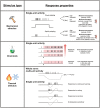The Physiology of Bone Pain. How Much Do We Really Know?
- PMID: 27199772
- PMCID: PMC4844598
- DOI: 10.3389/fphys.2016.00157
The Physiology of Bone Pain. How Much Do We Really Know?
Abstract
Pain is associated with most bony pathologies. Clinical and experimental observations suggest that bone pain can be derived from noxious stimulation of the periosteum or bone marrow. Sensory neurons are known to innervate the periosteum and marrow cavity, and most of these have a morphology and molecular phenotype consistent with a role in nociception. However, little is known about the physiology of these neurons, and therefore information about mechanisms that generate and maintain bone pain is lacking. The periosteum has received greater attention relative to the bone marrow, reflecting the easier access of the periosteum for experimental assessment. With the electrophysiological preparations used, investigators have been able to record from single periosteal units in isolation, and there is a lot of information available about how they respond to different stimuli, including those that are noxious. In contrast, preparations used to study sensory neurons that innervate the bone marrow have been limited to recording multi-unit activity in whole nerves, and whilst they clearly report responses to noxious stimulation, it is not possible to define responses for single sensory neurons that innervate the bone marrow. There is only limited evidence that peripheral sensory neurons that innervate bone can be sensitized or that they can be activated by multiple stimulus types, and at present this only exists in part for periosteal units. In the central nervous system, it is clear that spinal dorsal horn neurons can be activated by noxious stimuli applied to bone. Some can be sensitized under pathological conditions and may contribute in part to secondary or referred pain associated with bony pathology. Activity related to stimulation of sensory nerves that innervate bone has also been reported in neurons of the spinoparabrachial pathway and the somatosensory cortices, both known for roles in coding information about pain. Whilst these provide some clues as to the way information about bone pain is centrally coded, they need to be expanded to further our understanding of other central territories involved. There is a lot more to learn about the physiology of peripheral sensory neurons that innervate bone and their central projections.
Keywords: bone; bone marrow; bone pain; electrophysiology; nociception; pain; periosteum.
Figures



Similar articles
-
Mechanically sensitive Aδ nociceptors that innervate bone marrow respond to changes in intra-osseous pressure.J Physiol. 2017 Jul 1;595(13):4399-4415. doi: 10.1113/JP273877. Epub 2017 May 4. J Physiol. 2017. PMID: 28295390 Free PMC article.
-
Identifying spinal afferent (sensory) nerve endings that innervate the marrow cavity and periosteum using anterograde tracing.J Comp Neurol. 2020 Jul 15;528(11):1903-1916. doi: 10.1002/cne.24862. Epub 2020 Jan 29. J Comp Neurol. 2020. PMID: 31970770
-
Adeno-associated virus serotype rh10 is a useful gene transfer vector for sensory nerves that innervate bone in immunodeficient mice.Sci Rep. 2017 Dec 12;7(1):17428. doi: 10.1038/s41598-017-17393-z. Sci Rep. 2017. PMID: 29233995 Free PMC article.
-
An understanding of bone pain: A narrative review.Bone. 2020 May;134:115272. doi: 10.1016/j.bone.2020.115272. Epub 2020 Feb 13. Bone. 2020. PMID: 32062002 Review.
-
Molecular Mechanisms That Contribute to Bone Marrow Pain.Front Neurol. 2017 Sep 11;8:458. doi: 10.3389/fneur.2017.00458. eCollection 2017. Front Neurol. 2017. PMID: 28955292 Free PMC article. Review.
Cited by
-
Comparison of Platelet Rich Plasma and Prolotherapy in the Management of Osteochondral Lesions of the Talus: A Retrospective Cohort Study.Med Sci Monit. 2019 Jul 30;25:5640-5647. doi: 10.12659/MSM.914111. Med Sci Monit. 2019. PMID: 31358724 Free PMC article.
-
AAAPT Diagnostic Criteria for Acute Knee Arthroplasty Pain.Pain Med. 2020 May 1;21(5):1049-1060. doi: 10.1093/pm/pnz355. Pain Med. 2020. PMID: 32022891 Free PMC article.
-
Antibody-induced pain-like behavior and bone erosion: links to subclinical inflammation, osteoclast activity, and acid-sensing ion channel 3-dependent sensitization.Pain. 2022 Aug 1;163(8):1542-1559. doi: 10.1097/j.pain.0000000000002543. Epub 2021 Nov 19. Pain. 2022. PMID: 34924556 Free PMC article.
-
A randomized controlled trial comparing nerve block and mandibular infiltration techniques in posterior mandible implant surgeries.J Clin Exp Dent. 2018 Oct 1;10(10):e1003-e1010. doi: 10.4317/jced.54330. eCollection 2018 Oct. J Clin Exp Dent. 2018. PMID: 30386507 Free PMC article.
-
Role of the Peripheral Nervous System in Skeletal Development and Regeneration: Controversies and Clinical Implications.Curr Osteoporos Rep. 2023 Oct;21(5):503-518. doi: 10.1007/s11914-023-00815-5. Epub 2023 Aug 14. Curr Osteoporos Rep. 2023. PMID: 37578676 Free PMC article. Review.
References
-
- Arnoldi C. C. (1990). Intraosseous engorgement-pain syndromes. The pathomechanism of pain, in Bone Circulation and Bone Necrosis, eds Arlet J., Mazières B. (Berlin; Heidelberg: Springer; ), 253–259. 10.1007/978-3-642-73644-5_52 - DOI
Publication types
LinkOut - more resources
Full Text Sources
Other Literature Sources

